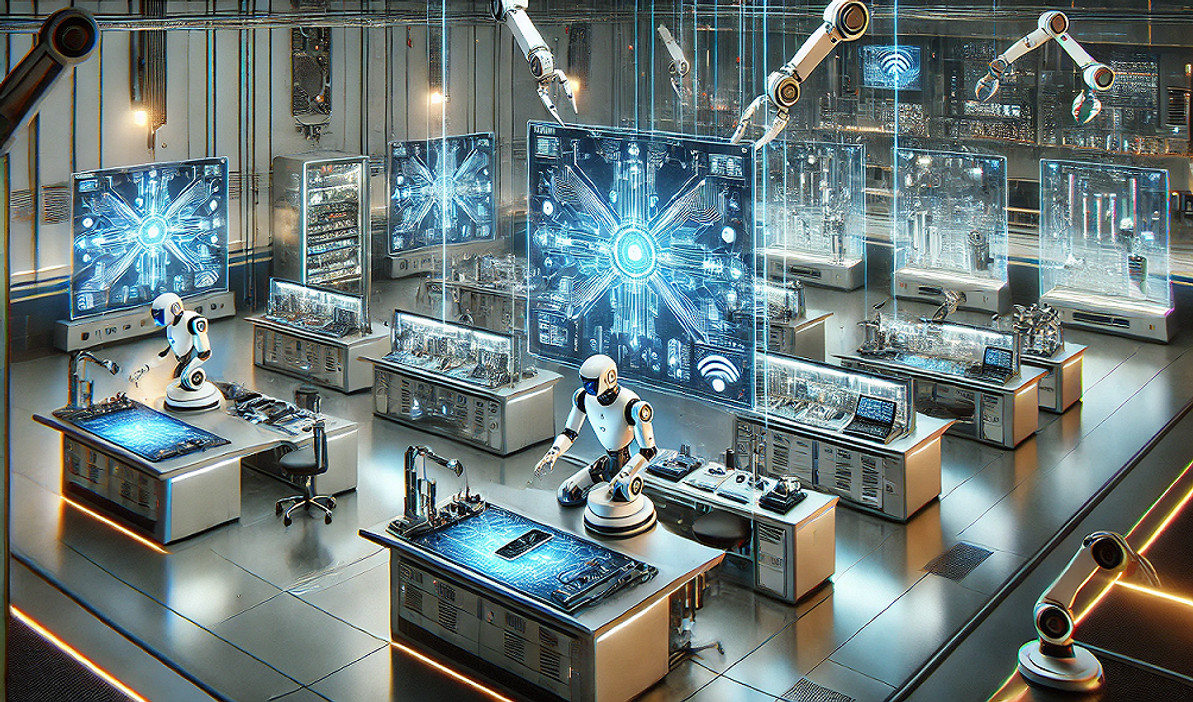Increasing Demand for AI and Automation in Tech Industry
The technical repair business is undergoing major turmoil due to advances in artificial intelligence and automation. From diagnosing problems in mobile phones and computers to fixing complex components, these technologies make repairs faster, more efficient, and more accessible. The tools and methods used to maintain and repair gadgets evolve with their sophistication. Here's how AI and automation are reshaping the future of mobile, laptop, and component repair.
1. Smarter Diagnostics AI: The days of using trial and error to troubleshoot are over. AI-powered diagnostic tools are now integral to the repair process, providing precise and speedy diagnosis of problems.
- Mobile Repairs: AI algorithms employ system logs, performance measurements, and user data to identify software or hardware problems such as battery drain, overheating, or app crashes.
- Laptop Repairs: Advanced diagnostic tools scan components like RAM, SSDs, and motherboards in minutes, finding flaws such as circuit failures or overheating.
- Parts Testing: Artificial intelligence can assess the health of individual components like displays, batteries, and CPUs, ensuring that only problematic parts are replaced, saving time and money.
- These technologies significantly cut the time spent on diagnosis, allowing repair shops to serve more customers effectively.
2. Automation in Complex Repairs: Automation is proving to be a game-changer for repairing intricate and delicate components, particularly in modern devices where miniaturization is the norm.
- Screen Repairs: Automated machines can replace damaged screens on smartphones and laptops with unmatched precision, ensuring proper alignment and functionality.
- Battery Replacement: For devices with glued-in batteries, robots can safely remove and replace them, avoiding risks associated with manual handling.
- These automated solutions not only speed up repairs but also maintain consistency and quality, making them ideal for high-demand repair centers.
3. Predictive Maintenance: A Proactive Approach: AI is transforming the repair sector from a reactive to a proactive paradigm through predictive maintenance. AI identifies future problems ahead of time by evaluating real-time data.
- For smartphones: AI monitors device health, such as battery life and CPU efficiency, and notifies users when replacements or updates are required.
- For laptops: Predictive technologies evaluate fan speeds, thermal performance, and storage health to identify future problems such as overheating or drive failure.
- This proactive strategy minimizes downtime and guarantees that consumers have uninterrupted device functionality.
4. AI-Powered Customer Interaction: AI is not just altering repairs; it is also improving customer interactions, making the process more efficient and transparent.
- Virtual Assistants: AI-powered chatbots assist clients in troubleshooting fundamental difficulties, such as app crashes or connectivity issues, without the need to contact a repair shop.
- Real-time information: AI algorithms deliver real-time information on repair status, keeping consumers aware of progress and expected completion times.
- Personalized Solutions: Based on usage patterns, AI can recommend services such as protective accessories, extended warranties, or upgrades that are specific to the customer's needs.
- This degree of participation fosters trust and increases client loyalty.
5. Sustainable Repairs with Automation: Sustainability is becoming increasingly important in the repair sector, and AI and automation are driving environmentally friendly practices.
- E-garbage Management: Automated technologies efficiently deconstruct electronics to separate recyclable components from garbage.
- Reusable components Identification: AI determines which components of broken equipment can be recovered and reused, decreasing the requirement for new production.
- Energy-Efficient Repairs: Automated tools work with great precision, reducing resource waste during repairs.
- These methods support global sustainability goals and appeal to environmentally conscientious clients.
6. Overcoming Industry Challenges: While AI and automation provide enormous benefits, the repair business faces problems in implementing these technologies:
- High initial costs: Advanced AI systems and automated tools demand a large investment, which is a hurdle for small repair enterprises.
- Training and skill development: To run and maintain AI-driven systems, technicians must be improved, which takes time and resources.
- Job Displacement Concerns: While automation may lessen the demand for certain manual labor, it also creates opportunities for highly skilled workers.
- The key to overcoming these obstacles is to strike a mix between traditional repair skills and cutting-edge technologies.
7. The Future of Repairs: A Collaborative Ecosystem: The future of the technical repair sector is a collaborative environment in which AI, automation, and human expertise operate.
- Mobile and laptop repairs: Advanced diagnostic and automated technologies make operations more efficient, while technicians concentrate on intricate problem resolution and customer care.
- Parts Repair and Replacement: Automation improves quality and consistency in component repairs, lowering turnaround times and costs.
- Customer-Centric Services: AI-powered solutions increase transparency and convenience, improving the overall customer experience.
- Repair businesses that adopt these advances will not only remain competitive but will also establish new industry norms.
Conclusion:
AI and automation
are no longer optional in the technical repair business; they are necessary.
These technologies offer speedier diagnosis, precise repairs, and
environmentally friendly procedures while improving the client experience.
Whether it's repairing a damaged smartphone screen, replacing a MacBook
battery, or detecting a faulty motherboard, the combination of AI and
automation makes repairs smarter, faster, and more dependable.
As the industry evolves, businesses that invest in these improvements will lead
the way, resulting in a future in which repairs are smooth and available to
everyone.
Recent Posts
-
How Water Damage Affects Your Phone & What to Do
Understanding Water Damage in Phones Accidental exposure to water is one of the most common reasons …4th Oct 2025 -
Why Your Phone Overheats | And What You Can Do to Fix It
In today’s fast-paced digital world, our phones do more than ever from video streaming and gaming to …20th Sep 2025 -
MagSafe Explained: How It Works and Why It Matters | Westcoast Repairs Australia
MagSafe Explained: How It Works and What You Need MagSafe has quickly become one of Apple’s most exc …13th Sep 2025




